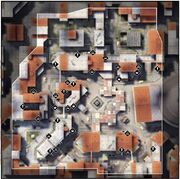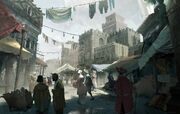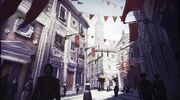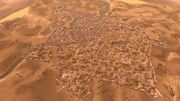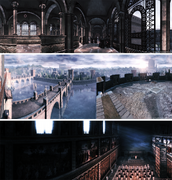Francesco75 (talk | contribs) |
Francesco75 (talk | contribs) |
||
| Line 17: | Line 17: | ||
==History== |
==History== |
||
===Isu era=== |
===Isu era=== |
||
| − | During the [[Isu Era]], the [[Isu|First Civilization]] built at least three sites near the future location of Rome. The Isu [[Jupiter]], [[Minerva]] and [[Juno]] were remembered as the [[Capitoline Triad]].<ref name="Brotherhood"/> |
+ | During the [[Isu Era]], the [[Isu|First Civilization]] built at least three [[Temple (Isu)|sites]] near the future location of Rome. The Isu [[Jupiter]], [[Minerva]] and [[Juno]] were remembered as the [[Capitoline Triad]] and assimilated to gods.<ref name="Brotherhood"/> |
===Roman era=== |
===Roman era=== |
||
Revision as of 18:32, 22 May 2019

|
Patience, brothers. Soon we will reveal the secrets of Assassin's Creed: Identity. This article has been identified as being out of date. Please update the article to reflect recent releases and then remove this template once done. |
- "Roma is the pillar that holds our entire enterprise aloft. She cannot waver; which means neither can you."
- ―Cesare Borgia to his allies.[src]
Rome (Latin and Italian: Roma) is the capital city of Italy. During the Renaissance, Rome was the capital of the Papal States and headquarters of the Roman Rite of the Templar Order. Also, as part of Rome's liberation, the city became the base for the Italian Brotherhood of the Assassins. During the Renaissance, Rome was divided in four districts: Antico District, Campagna District, Centro District and Vaticano District.
History
Isu era
During the Isu Era, the First Civilization built at least three sites near the future location of Rome. The Isu Jupiter, Minerva and Juno were remembered as the Capitoline Triad and assimilated to gods.[1]
Roman era
Archaeological evidence supports that Rome grew from pastoral settlements on Colle Palatino, the future site of the Roman Forum, upon which there are several caves. According to legends, the city of Rome was founded in 753 BCE by the King Romulus, son of the god Mars bred by a she-wolf on the Palatine Hill, which became the place of the royal palace. Around 600 BCE, the King Lucius Tarquinius Priscus ordered the construction of the Cloaca Maxima, once of the world's first major sewage systems.[2]
Eventually, the Republic of Rome was founded in c. 510 BCE, which eventually began to conquer territories through Mediterranean Sea, having influence over Gaul, Hispania, Greece, Egypt and Middle-East.[2]
In 179 BCE, the Pons Aemilius connecting the west bank of the Tiber to Rome was rebuilt in stone. Between 144 – 140 BCE, the Praetor Quintus Marcius Rex built the longest aqueduct of the city, running on 91 miles. In 62 BCE, Lucius Fabricius built a bridge connecting the Tiber Island to Rome.[2]
In 49 BCE, a Civil War began between the consuls Pompey and Julius Caesar. In this conflict, Pompey died and Caesar became the dictator of the Republic. On 15 March 44 BCE, Caesar was stabbed and killed in the Theatre of Pompey by fourty senators, calling themselves the "Liberatores", who secretly were Hidden Ones. These Liberatores were led by Marcus Junius Brutus and Gaius Cassius Longinus, and helped by the Egyptian Hidden One Aya.[3][4]
After Caesar's death, the Republic was led by Marcus Antonius, Lepidus and Octavianus, Caesar's adoptive son. As Antonius committed suicide after being defeated by Octavianus in 30 BCE, Rome became an Empire in 27 BCE with Octavianus as his first Emperor known as Augustus. Under his reign, he constructed many monument. He finished the Basilica Julia in honor of his adoptive father, ordered the construction of the Pantheon to celebrate the victory of Agrippa over Antonius, and the Mausoleum of Augustus where he was buried with other important persons.[2]
Between 18 and 12 BCE, the magistrate Caius Cestius constructed a pyramid which beared his name later.[2]
Between 20 and 23 CE under the reign of the Emperor Tiberius, the Praetorian Prefect Sejanus constructed the Castra Praetoria to house the nine cohorts of the Praetorian Guard.[2]
In the year 41 CE, the Hidden Ones Leonius assassinated the Emperor and Templar puppet Caligula in Rome, whom he stabbed with a dagger.[5] His successor Claudius finished the construction of his aqueduct in 52 CE.[2]
Between 54 and 68 CE, Rome was ruled by the Emperor Nero, who was known for his tyranny and extravagance. In 64 CE, a Great Fire occured in Rome. Some accused Nero to intentionally started the fire to make room for his golden palace on Esquiline Hill. It was also likely that Nero used the aqueducts to build his palace because they did not give water to civilians anymore for a time. As Nero accused the christians to have start the Fire. The Apostle and Jesus' disciple Peter was crucifixied in the Circus of Nero circa 68 CE where he was buried.[5]
Under the Flavian dynasty, many monument were constructed by the Emperors. Between 72 and 80 CE, the Colosseum was built as a place of entertainment. The Temple of Vespasian and the Arch of Titus honored the two first Emperor of the dynasty. Domitian ordered the construction of a stadium in Rome.[2]
During the 2nd century CE, the Roman Empire knew a Golden Age under the Nerva-Antonine. The Emperor Trajan and his architect Apollodorus of Damascus constructed three monument to the glory of the Emperor: a market, a column and public baths on the ruins of Nero's Golden Palace. Trajan's successor, Hadrian ordered the construction of a mausoleum bigger than Augustus' one and restored the Pantheon. In 140 CE, a part of the Circus Maximus collapsed, killing 1,112 spectators. The same year, the Empress Faustina the Elder died. Her husband Antoninus Pius erected a temple in her honor on the Roman Forum. 20 years later, the Emperor died and the temple was also dedicated to him. During this century, the Catacombs of Rome were constructed and served as a buried place for the Christians who hid in the city.[2]
At the end of the 2nd century, the Severian dynasty ruled over Rome. To celebrate his victory over the Parthians, the Emperor Septimius Severus constructed an arch near the Colosseum. His sons Geta and Caracalla succeded to him but in 211 CE, Caracalla killed Geta and destroyed all records of Geta's existence, as his representations on the arch. Caracalla ordered the construction of public baths with the Acqua Antoniniana and restored the Porta Tiburtina.[2]
In 271 CE, the Emperor Aurelian began the construction of walls around the city, connecting numerous archs and gates. His successor Probus completed his work in 275 CE. In 283 CE, the Temple of Saturn was restored.[2]
At the end of the 3rd century, the Emperor Diocletian constructed public baths on the Viminal Hill. In 308 CE, the Emperor Maxentius began the construction of a basilica in the Roman Forum. After being defeated by Constantine I, the basilica was finished by his Maxentius' rival, who constructed an arch to remember his victory. As Constantine authorized the Christian religion, in 326 CE the St. Peter's Basilica was constructed on the site of a vault of the Isu. The Lateran Palace became the principal residence of the Pope.[2]
In 401 CE, Hadrian's Mausoleum was changed into a military fortress. In 410 CE, the King of the Visigoths Alaric I entered in Rome by the Porta Salaria with his army and began to sacked the city. The Basilica Aemilia was destroyed during the attack and the urns and ashes of Hadian's Mausoleum were scattered by looters. In 476 CE, the Western Roman Empire fell, ending the rule of the Romans on the city.[2]
Middle Age
During the 6th century, Rome was disputed between the Ostrogoths and the Eastern Romans. In 536 CE, the Roman General Belisarius entered in the city by the Porta Asinaria and took back Rome. A year later, the Ostrogoths besieged the city, cutting the water supply and attacking the Hadrian's Mausoleum. During the Gothic Wars in 545 CE, much of Aurelian Walls were destroyed by the army of the Ostrogoth King Totila. In 546 CE, a traitor opened the Porta Asinaria to the Ostrogoths who sacked the city. In 549 CE, the treason of the Isaurian garrison permitted to the Ostrogoths to enter by the Porta Ostiense and sacked another time the city.
During the Middle Age, the Church and the Popes increased their influence in Rome. Around 550's CE, Pelagius I ordered the construction of the Church of the Twelve Holy Apostles to celebrate the victory of the Roman General Narses over the Ostrogoths. At the end of the 6th century, Gregory I built the church Santa Maria in Vallicella. In 609 CE, Boniface IV converted the Pantheon into a church. In 756 CE, the Roman Catholic Church managed to take power in Rome founding its own state with the Pope as the spiritual leader of Christian Europe.[2]
In 852 CE, after an sack from Muslim raiders, the Vatican was enclosed by the Leonine Walls, composed by the Porta Viridaria and the Porta Cavalleggeri.[2]
After that, Rome became an economic and cultural powerhouse in Europe, even though Florence surpassed Rome as the centre of the Italian Renaissance. Due to the rivalry between the two cities, the papacy spent vast amounts of money to create cultural masterworks.[2]
Renaissance
- "I say we work here. In Roma. Erode the Borgia’s influence while restoring our own. And in fact, I want to begin right now."
- ―Ezio to his allies, before beginning the liberation of Rome, 1501.[src]
In 1476, cardinal Rodrigo Borgia, Grand Master of the Italian Templars and a powerful figure in Vatican politics, briefly left the city to discuss his Order's plans, before returning to affirm Papal approval. Assent was given by Pope Sixtus IV, and the Templars were provided with military support for their endeavors.[6]
In 1492, Rodrigo became Pope Alexander VI, and head of the Papal States and Catholic Church. Ruling from Rome, he was left alone by the Assassins for the most part until 1499, when Ezio Auditore da Firenze learned that the Vatican Vault was located in Rome, beneath the Sistine Chapel.[5]
In 1500, following the Siege of Monteriggioni that was led by Cesare Borgia, Ezio returned to Rome to exact his revenge. At the time, the city had fallen far behind those of Florence and Venice, and had grown stagnant in terms of development, due to the influence of the Borgia.[1]
The Borgia maintained oppression over the city with towers located throughout Rome, which prevented shops from opening. In order to free Rome of the Borgia influence, Ezio killed the overlords of the towers and burned the structures themselves to the ground, taking them over for the Assassin Order afterwards.[1]
Additionally, due to the loss of Monteriggioni, Ezio established the Assassins Guild in Rome, and set up its headquarters on Tiber Island. By recruiting several Roman civilians as Assassin apprentices, the Brotherhood worked to free Rome of Templar control, which was accomplished by the death of Rodrigo in 1503 and the subsequent Pope Julius II having Cesare arrested.[1]
Three years later, the Hermeticists kidnapped Leonardo da Vinci to open the Temple of Pythagoras beneath Rome. Ezio rescued him, and the duo discovered the Pythagorean Vault inside the Temple, which gave the coordinates for the Grand Temple in North America.[7]
Modern times
In 2012, the Assassin Clay Kaczmarek was tasked to infiltrate the Abstergo laboratory in Rome, as Subject 16 of the Animus Project. Clay remained in the lab for the remainder of his physical life, until the consequences of the Bleeding Effect drove him insane and led him to commit suicide. Clay would then continue to provide assistance within the Animus to his successor, Desmond Miles, via an implanted digital consciousness.[5]
In September 2012, Desmond Miles was captured by the Templars and brought to the same facility in Rome. There, Desmond was marked Subject 17 of the Animus Project, in which Warren Vidic examined the genetic memories of Desmond's ancestor, Altaïr Ibn-La'Ahad, for a week.[8] Desmond subsequently escaped from the facility with the help of Lucy Stillman, who in reality was a Templar part of Project Siren. The pair then made their way to an Assassin hideout nearby, where Desmond relived Ezio's memories in order to gain his abilities through the Bleeding Effect.[5] Once Vidic and the Templars located the Assassins, Desmond and his team were forced to relocate to another safer location in Monteriggioni.[1]
On October 10, 2012, Desmond Miles, Lucy Stillman, Rebecca Crane and Shaun Hastings returned to Rome to retrieve the Apple of Eden, after Desmond had relived Ezio's memories in Rome and found that the Assassin had locked the Piece of Eden in the Colosseum Vault, as well as leaving the password to unlock the Vault on the wall of the Sanctuary, where they were stationed.[1]
On December 12, 2012, Desmond returned to Rome, to the same Abstergo laboratory he had been held in months before, to rescue his father who had been captured by the Templar organization. Desmond fought his way to Warren Vidic's office, killing Daniel Cross and many Abstergo guards along the way. There, Desmond managed to rescue his father and kill Vidic using his Apple of Eden, which he also used to escape the laboratory.[1]
As well as this, Abstergo Industries used Rome as a simulated training location in the primary and secondary stages of their Animi Training Program.
The simulation was set in the Centro District, depicting the market square, upon which a great many market stalls had been set up, located in front of the Pantheon and the surrounding residences. Although the Pantheon could be seen, its interior and exterior were inaccesible. The streets themselves were relatively spacious, but the many hidden alleyways allowed people to slip away from the masses with ease.
Rome, like most of the simulated locations in the first and second stage, had two aesthetic variations. As such, it could be utilized during the day or at dusk.
Layout
The city was divided into four districts: Centro, Antico, Campagna, and the Vaticano district. With the exception of the Vaticano district, these were also subdivided into 12 territories, each one controlled by a Borgia tower.[1]
Landmarks in Rome included the Pantheon, the Colosseum, the Passetto di Borgo, the Castel Sant'Angelo and the Sistine Chapel.[5][1]
Trivia
- In-game, the city was tilted roughly 15 degrees to the right from its real counterpart.
- While Rome and Florence's architecture were historically similar during the game's time period, the developers of Assassin's Creed: Brotherhood designed Rome with its later Baroque style to be more familiar to their audience.
- The area where Ezio climbed up to the Castel Sant'Angelo from the river in Assassin's Creed II was unreachable in Assassin's Creed: Brotherhood, with fencing and blockades along the Castello and Vaticano district.
- The buildings seen north of the Passetto di Borgo in Assassin's Creed II did not appear in Assassin's Creed: Brotherhood.
- In the Assassin's Creed series, there were two bridges that could clearly be seen that led into the Vaticano district of Rome: the Ponte Sant'Angelo, leading first into Castel Sant'Angelo, and the Ponte Vittorio Emanuele II, which lay west of the Ponte Sant'Angelo. While both bridges could be seen in Assassin's Creed II, the Ponte Vittorio Emauele II was missing in Assassin's Creed: Brotherhood.
- While the final memory of Assassin's Creed II took place in 1499, construction on the Ponte Emanuele did not begin until 1886. This is one of the largest anachronisms in the series to date, and an oversight of 387 years.
Gallery
Appearances
- Assassin's Creed: Lineage (first appearance)
- Assassin's Creed II
- Assassin's Creed: Project Legacy
- Assassin's Creed: Brotherhood
- Assassin's Creed: Identity
- Assassin's Creed: Origins
- Assassin's Creed: Origins comic
References
- ↑ 1.0 1.1 1.2 1.3 1.4 1.5 1.6 1.7 1.8 Assassin's Creed: Brotherhood
- ↑ 2.00 2.01 2.02 2.03 2.04 2.05 2.06 2.07 2.08 2.09 2.10 2.11 2.12 2.13 2.14 2.15 Assassin's Creed: Brotherhood – Database
- ↑ Assassin's Creed: Project Legacy
- ↑ Assassin's Creed: Origins
- ↑ 5.0 5.1 5.2 5.3 5.4 5.5 Assassin's Creed II
- ↑ Assassin's Creed: Lineage
- ↑ Assassin's Creed: Brotherhood - The Da Vinci Disappearance
- ↑ Assassin's Creed
| ||||||||||||||||||||||||||||
| ||||||||||||||||||||||||||||
| |||||||||||||||||||||||||||||||||||||
| ||||||||||||||||||||||||||||||||||
| ||||||||||||||||||||||||||||||||||||||||
| |||||||||||||||||||||||||
| |||||||||||||||||||||||||
| ||||||||||||||||||||||||||||||||||||||||
| |||||||||||||||||||||||||
| |||||||||||||||||||||||||||||||

